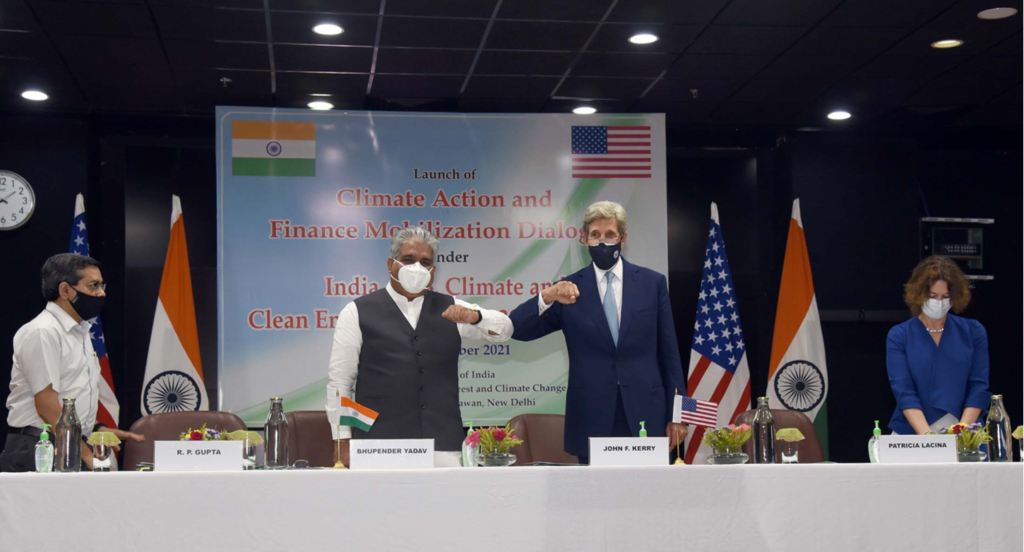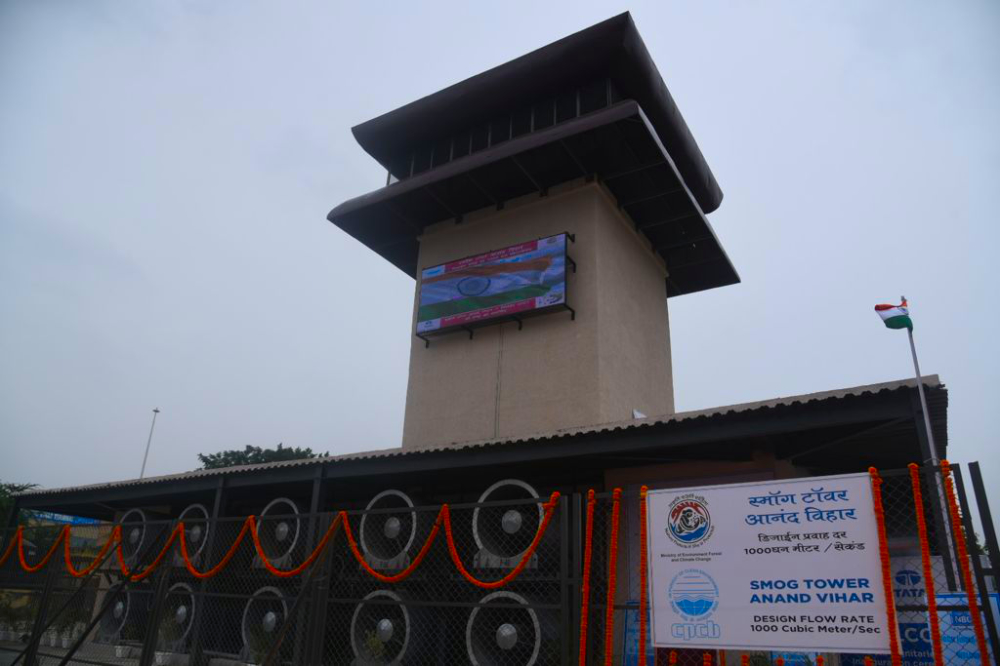IndiaWilds Newsletter Vol. 13 Issue IX
ISSN 2394 – 6946
Smog Tower not a Holistic Sustainable Solution
India for the first time got a smog tower when the Union Minister for Environment, Forest and Climate Change, Shri Bhupender Yadav virtually inaugurated one tower in Anand Vihar, Delhi on 7th September 2021. A smog tower is a structure designed as large/medium scale air purifiers to reduce air pollution, usually by forcing the air through filters.
The smog tower at Anand Vihar is 20 meter high and is of downdraft type. Polluted air come in from the top of the tower and passes through a filtration system and as a result clean air comes out of the bottom. The filtration system used in the tower has been designed by University of Minnesota. They claim that the filtration system would have an efficiency of 90%. To ensure the air flow, 40 fan units have been installed to provide a design airflow rate of 1000 m3/sec. This filtration system is supposed to capture particulate matter and the resulting cleaner air is released back so that the overall air in the area is going to become better for humans.
We humans fancy our ability to create technological solutions to our problems. This has resulted in creating this concept of Smog towers. While designing and setting up smog towers makes the authorities claim that they are working hard to reduce the overall level of pollution that has engulfed our cities, the question no one is asking is whether this technological solution is enough.
Nature has a unique design with different species bound with each other on a complex web of interdependencies. The oxygen that is present in the air that we inhale is key for our survival. We give back carbon dioxide while breathing out. This carbon dioxide is used up by the plants and trees and algae. Plants take up water through their roots and using the cholorphyll in the leaves they absorb the blue and red light waves from the sunlight and covert the carbon dioxide in air to glucose and store it. They release the oxygen as a byproduct. There are also plants that fix the nitrogen from the air. The dust and particulate matter in the air is trapped by the leaves and the overall air becomes cleaner.
Research has shown that roads lined with trees have a big impact on trapping the particulate matter and reducing the pollution. Unfortunately, these days we believe cutting down trees and concretising the land makes it look neat and tidy. Our ever growing vehicle numbers and the traffic congestion also results in road expansion and the inevitable cutting down of old hard growth trees. Our aesthetic sense has also changed. We are aping the British habit of creating lawns by clearing the undergrowth and cutting trees. Offices as well as individual houses and apartments also prefer to cut down trees and bushes and replace it with concrete or lawns. As a result our urban areas have become devoid of trees. Since we have killed trees that used to act as Natures air cleansing mechanism, the air pollution in our urban areas remain unchecked.
Meanwhile, from next month onwards, Delhi will start choking due to the farmers burning paddy stalk in Punjab and Haryana. There have been many solutions proposed and even the Hon’ble Supreme Court has given various directives. Despite that, we are still struggling to control the paddy stalk burning and find a sustainable solution. Clearly, we have other priorities in mind else a country which could send spacecraft to mars at a fraction of the cost of other countries could have easily shown leadership to resolve the air pollution issue.
The Government doesn’t have any intention to right the wrongs and solve the core issues of air pollution. It is content in creating technological solutions which are easier to show case. Technological solutions also means creating projects with hefty budgets, awarding of contracts to parties and historically politicians have been accused of benefitting from awarding contracts to parties of their choice.
MoEF&CC (Ministry of Environment, Forests and Climate Change) has initiated a National Clean Air Programme (NCAP) in the country since 2019 and has set targets to achieve 20 to 30 % reduction in Particulate Matter (PM10 and PM2.5) concentrations by 2024 across the country.
City-specific action plans for improving air quality for 132 Non- attainment cities (NACs)/Million Plus Cities (MPC) targeting city specific air polluting sources (Soil & Road Dust, Vehicles, Domestic Fuel, MSW Burning, Construction Material and Industries) have been prepared and are already being implemented. So far, 375.44 crores have been released to 114 cities during FY 2019-20 & 2020-21 for initiating actions under city action plan. Further, 4400 cores have been released to 42 cities with million plus population as per recommendations of 15th Finance Commission report for FY 2020-21. This is in addition to funds available through various Central and State government schemes.
The citizens of this country also know that they have to somehow manage with this air pollution. They know that there are not enough green areas that can act as a barrier against the air pollution. A sense of fatality has sunk in with respect to lack of green areas in our cities. So increasingly people are buying indoor air purifiers to help purify the air inside their house. Hence, it is easier to setup Smog towers which are being projected as viable technological solution to air pollution and make an impression that the Government is doing its job. Sadly the Government never tells how many such smog towers are needed to make the air of Delhi pure. One can easily guess the reason.
Clean Air is intricately linked to a host of benefits for the human beings. Every year the incidence of diseases like asthma, bronchitis, cancer etc are increasing. Air pollution is one of the major cause of such diseases. Air pollution is causing telomere shortening in kids and adolescents. With such genetic changes happening to our youngsters due to air pollution, we are creating a weaker India. With rise in diseases there is impact on productivity of our workforce. It would impact our economy as well. Unfortunately, there is no effort by the Government to rethink the way our cities are structured, along with transport, roads, green areas and polluting industries and adopt a sustainable lifestyle for citizens. Unless the Government actively links all policy approaches to give paramount importance to conserve public goods like water, air and Earth, the future of India’s civilization would be at stake. History will not be kind to us, if we don’t immediately rethink our wasteful ways and adopt a sustainable lifestyle.
Conservation News:
Two more Indian Beaches get coveted International Blue Flag Certification
The coveted International eco-label “Blue Flag”, has accorded the Blue Flag Certification for 2 new beaches this year –Kovalam in Tamil Nadu and Eden in Puducherry beaches.
Foundation for Environment Education in Denmark (FEE) which accords the globally recognized eco-label – Blue Flag certification, has also given re-certification for 8 nominated beaches Shivrajpur-Gujarat, Ghoghla-Diu, Kasarkod and Padubidri-Karnataka, Kappad-Kerala, Rushikonda- Andhra Pradesh, Golden-Odisha and Radhanagar- Andaman and Nicobar, which were awarded the Blue Flag certificate last year.
For more details click on the below link –
COP26 should focus on climate finance in scope, scale and speed and transfer green technologies at low cost demands India at UN
20 September, 2021
Representing India virtually at the UN Secretary General’s meeting with select leaders on Climate Change on 20th September,2021 convened by H.E. António Guterres, United Nations Secretary General and H.E. Boris Johnson, Prime Minister of United Kingdom, the Minister for Environment, Forest and Climate Change, Shri Bhupender Yadav underlined the need for upholding the principles of UNFCCC process, for any successful outcome in any climate change negotiations including the upcoming COP 26.
In the Meeting, crucial climate actions on finance, mitigation and adaptation required for tackling the climate crisis were discussed.
The Environment Minister mentioned that in light of the recent IPCC findings and the latest UNFCCC Synthesis Report, and that the developed countries have collectively emitted more than their estimated emission allowances in 2008-2020 period, they should take greater action on mitigation and provide financial support to developing countries.
Shri Yadav stressed that even at the UNFCCC there is a very urgent need for giving due importance to adaptation and discuss whether the scale of resources is commensurate with the scale of the needs of developing countries.
The Minister also underlined that ambitious climate action in developing countries is dependent on ambitious support from developed countries under the Paris Agreement, and called upon the developed countries to fulfil their promise of the USD 100 billion per year goal made in 2009. COP26 should focus on climate finance in scope, scale and speed and transfer of green technologies at low cost.
The world needs rapid, sustained, and deep emission cuts in this decade rather than distant targets says India at the Major Economies Forum on Energy and Climate
17 September, 2021
Representing India at the Major Economies Forum on Energy and Climate (MEF) convened virtually by US President, Joe Biden, on September 17, 2021, the Minister for Environment, Forest and Climate Change, Shri Bhupender Yadavstated that combating climate change is a shared global challenge and our response must be based on the fundamental principles of equity and common but differentiated responsibilities and respective capabilities.
The Minister in his remarks mentioned that though India’sshare of world population is 17% but the country’sshare in cumulative historical emissions is just 4% and even the current annual emissions are only 5.2% of the global emissions and the per capita emissions are about a third of the global average. “It is clear that we are not a part of the problem, but we want to be a part of the solution to the climate crisis.”
emphasised the Minister at the meeting which aimed at facilitating candid dialogue among major emitters countries, both developed and developing, to garner political leadership to advance climate action.
Expressing India’s ambitious goals under the Paris Agreement, the Environment Minister highlighted India’s target of 450 GW of Renewable Energy by 2030 and mentioned that India’s solar capacity, drawing on the collaborative spirit of member countries through the International Solar Alliance, has increased fifteen times in the last six years.
The Minister of Environment concluded his remarks by echoing global sentiments for collective intent and concrete actions in tackling climate change. “The world needs rapid, sustained, and deep emission cuts in this decade rather than distant targets” said Shri Bhupender Yadav underscoring collaborative and cohesive global efforts to keep the Paris Agreement temperature goal within reach.
The virtual meeting built on the Leaders’ Summit on Climate conducted in April 2021 and was aimed at enabling dialogue and discussion and building consensus before COP26, which will set a precedent for climate efforts in the years to come.
India reiterates Renewable energy and Energy efficiency as its key pillars Climate Change strategies
India’s Minister of Environment, Forest and Climate Change, Shri Bhupender Yadav held a meeting with H.E. Dr Sultan Al Jaber, UAE Climate Envoy and Minister of Industry and Advanced Technology virtually today and discussed issues relating to COP 26, renewable energy and other related matters.
Dr Sultan Al Jaber, UAE Climate Envoy and Minister of Industry and Advanced Technology sought support of India for the UAE Initiative on Agriculture Innovation Mission for Climate (AIM-C) along with US and UK to be launched at COP26 to be held in Glasgow later this year.
India’s environment minister Shri Bhupender Yadav stated that renewable energy and energy efficiency are among the key pillars of Indian climate change strategies. India has worked to make sure that renewable energy, particularly solar energy, becomes cheaper than energy from fossil fuels.
The Minister further mentioned that India has already installed about 151GW of non-fossil fuel installed capacity with 39 percent of the total capacity installed and going ahead, India has declared an aspirational target of installing 450 GW of renewable energy by 2030.
The Environment Minister also mentioned about India’s Hydrogen Energy Mission, global initiatives such as International Solar Alliance (ISA), Coalition of Disaster Resilient Infrastructure (CDRI) and leadership group for Industry Transition (LeadIT) and underlined the need for prioritizing the concerns of developing countries, particularly in areas of implementation support including finance and technology.
The world over, countries have started shifting away from polluting fossil fuel to solar energy. Unfortunately, in some states in India, there is an effort to still set up coal-fired thermal power plants. Due to political pressure certain state governments are allowing setting up of these coal-fired thermal power plants and state electricity boards forced to get into costly power purchase agreements. This will burden the state electricity boards and consumers with costly power for a long time along with the pollution that comes with these coal-fired thermal power plants. Hope the Union Government seriously bans setting up of any new coal-fired thermal power plants in India.
First India-Japan High Level Policy Dialogue on Environment held today
The First India–Japan High Level Policy Dialogue was held virtually on 7th September 2021 between Mr. Bhupender Yadav, India’s Minister of Environment, Forest and Climate Change of Mr. Bhupender Yadav and Japan’s Minister of the Environment, Mr. KOIZUMI Shinjiro. Air Pollution, Sustainable Technologies and Transports, Climate Change, Marine Litter, Fluorocarbons, COP 26, etc were the issues discussed during the meeting.
In meeting, Mr. Bhupender Yadav acknowledged the importance of Indo-Japan bilateral cooperation on environment and appreciated efforts made by Japan in bringing new technologies in India. He also highlighted the achievements made India in tackling climate change.
Mr. Yadav stated that India and Japan may explore strengthening bilateral cooperation especially on circular economy and resource efficiency, low carbon technology, green hydrogen, etc. Given Japan’s expertise and technology on low carbon technology, the Environment Minister also requested Japan to consider joining the Leadership Group for Industry Transition, a global initiative spearheaded by India and Sweden.
Mr. KOIZUMI Shinjiro, Minister of the Environment of Japan mentioned that both countries can strengthen bilateral cooperation through the Joint Credit Mechanism (JCM), Coalition for Disaster Resilience Infrastructure (CDRI) and may also explore collaboration in areas endorsed by the G20, especially on climate, environment and energy.
Both sides agreed to further strengthen the bilateral cooperation on environment, and also to take forward the discussion on Joint Credit Mechanism (JCM).
Environment Minister says COP 26 should ensure a balanced outcome
10th September
Union Minister for Environment, Forest and Climate Change Shri Bhupender Yadav met with Danish Minister for Climate, Energy and Utilities, H. E. Dan Jorgensen to discuss on general bilateral cooperation between India and Denmark in the areas of environment and climate change. Minister Dan Jorgensen is on five days’ visit to India with a business delegation.
In the meeting, Mr. Bhupender Yadav acknowledged the historical and friendly ties between the two countries and highlighted the contributions of Denmark in the ‘White Revolution’ in India, because of which, today India is the largest producer of milk in the world.
Mr. Yadav also appreciated the contributions of Denmark in setting up of the Clean and Wind energy hub in Tamil Nadu and the companies from Denmark that have made significant investments in India in diverse sectors.
Both the Ministers’ held discussion on Green Strategic Partnership (GSP) and upcoming COP 26 meeting.
Reinstating the findings of the IPCC Physical Science Summary for Policy Makers (SPM) released recently, Shri Yadav highlighted that the world must recall about the forgotten phrases ‘Equity, CBDR-RC, and National Circumstances’ that are the bedrock of UNFCCC and its Paris Agreement and emphasized that COP 26 should ensure a balanced outcome with equal treatment to all agenda items like adaptation, finance, response measures, etc.
The Environment Minister’s also discussed on the Joint Action Plan to take forward the Green Strategic Partnership (GSP) in the environment sector. Mr. Yadav stated that India and Denmark may explore strengthening bilateral cooperation especially on climate change, clean energy, circular economy, and resource efficiency, etc.
Both sides agreed to further strengthen the bilateral cooperation on environment, and also to take forward the discussion on GSP and COP26.
India and Germany discuss to deepen partnership on Energy and Climate
10th September, 2021
A bilateral meeting was held between Union Minister of Environment, Forest and Climate Change, Shri Bhupender Yadav and Mr. Norbert Barthle and Dr.Maria Flachsbarth, Parliamentary State Secretariates, German Federal Ministry for Economic Cooperation and Development (BMZ) today at Indira Paryavaran Bhawan in New Delhi.
Both sides discussed at length on a wide range of environmental issues covering areas such as climate change, water scarcity, marine & air pollution, circular economy etc.
In the meeting, Shri Yadav acknowledged the importance of Indo-German bilateral cooperation on environment and appreciated efforts made by Germany in bringing new technologies in India. He also highlighted the India’s efforts in renewable energy front which will help in reducing the impact of climate change.
Both sides stressed on the importance of information exchange in bilateral programs keeping climate and SDG indicators in focus-Agro-Ecology, Solar Partnership Inter resilience.
India’s environment minister stated that India and Germany may explore strengthening bilateral cooperation especially on circular economy – treatment of solid waste (solar panels, batteries), wastewater among others.
India and US launch the Climate Action and Finance Mobilization Dialogue (CAFMD)
13 September, 2021
India and the United States of America (USA) launched the “Climate Action and Finance Mobilization Dialogue (CAFMD)”. The CAFMD is one of the two tracks of the India-U.S. Climate and Clean Energy Agenda 2030 partnership launched at the Leaders’ Summit on Climate in April 2021, by Prime Minister Shri Narendra Modi and US President Mr. Joseph Biden.
The dialogue was formally launched by Union Minister of Environment, Forest and Climate Shri Bhupender Yadav and Mr. John Kerry, U.S. Special Presidential Envoy for Climate (SPEC), at an event held in New Delhi.
Speaking at the launch, Shri Yadav said that the dialogue will not only strengthen India-US bilateral cooperation on climate and environment but will also help to demonstrate how the world can align swift climate action with inclusive and resilient economic development, taking into account national circumstances and sustainable development priorities.
“India and the United States are natural partners with shared values and our agenda encompasses all major pillars of our strategic priorities – including defence, security, energy, technology, education and healthcare,” said the Environment Minister emphasizing on the deep ties shared by the two mature and vibrant democracies.
Speaking at the launch of Climate Action and Finance Mobilization Dialogue (CAFMD), Mr. Kerry applauded Prime Minister Shri Narendra Modi for setting an ambitious target of achieving 450GW renewable energy by 2030 and congratulated India for already achieving 100 GW.
The US Climate envoy lauded India’s leadership role in demonstrating how economic development and clean energy can go hand in hand and stated that urgent Global Climate Action is the need of the hour. He stressed that India and US are working towards speedier deployment of clean energy.
The launch was preceded by a bilateral meet where both sides discussed at length a wide range of climate issues relating to COP26, Climate Ambition, Climate Finance, Global Climate Initiatives including International Solar Alliance (ISA), Agriculture Innovation Mission for Climate (AIM4C).

Reaching ‘net zero’ alone is not enough; need of the hour is deeds and not plain words to deal with climate change: Shri Bhupender Yadav
Minister for Environment, Forest and Climate Change, Shri Bhupender Yadav today said that the need of the hour is ‘deeds’ and not ‘plain words’ to deal with climate change and that reaching ‘net zero’ alone is not enough, emphasising that the Intergovernmental Panel on Climate Change (IPCC) report published recently is a clarion call for the developed countries to undertake immediate deep emission cuts and decarbonize their economies.
The Union Minister who was speaking at the LEADS (Leadership, Excellence, Adaptability, Diversity and Sustainability) event organized by FICCI under the theme- “Future of Partnerships”, highlighted the key issues of climate justice and sustainable lifestyle which have been prioritized by Prime Minister Shri Narendra Modi.
Shri Yadav informed the gathering about the initiatives taken by India in the last few years, both nationally and globally for promoting renewable energy noting that the country’s renewable power capacity is currently the 4th largest in the world.
Speaking on India’s ambitious targets and futuristic initiatives, the Environment Minister said, “Prime Minister Shri Narendra Modi has further announced the aspirational target of increasing our renewable energy capacity to 450 GW and India has also announced Hydrogen Energy Mission 2021-22 for generation of hydrogen from green power sources”, emphasising on the important and vital role of clean energy derived especially from renewable.
The Minister further said that the energy transition in different parts of the world will be different and India has much to offer and share in terms of its experience with other countries embarking on a similar journey to address energy access issues, while also addressing the growing energy demand with renewable energy.
Listing green partnerships between India and European nations, Shri Yadav said that India and Europe remain key economic partners who are all set to scale up their cooperation in years to come and expressed confidence that India and Europe will further take forward their partnership in a lot many emerging sustainable technologies, such as Battery Storages, Green Hydrogen, Off Shore Wind Energy installation challenges or commissioning, Solar Photovoltaic, Solar Thermal, Waste to Energy/Bio Energy, Wind Energy, Hydrogen and Fuel Cells , Energy Storage, Tidal Energy, Geothermal Energy ,etc.
The Minister stated that developed Countries, however, should also provide lead markets for products of green technologies and drive down costs, such that these can be deployed in developing economies at scale.
India has engaged in bilateral engagements with Germany, UK, and Denmark in the energy sector in the European Region. As a result of these engagements, many significant achievements could be made in the area of sustainable and green technologies.
Speaking on the role of the private sector in creating low-carbon sustainable economies, Shri Yadav said that the private sector companies should be encouraged to develop voluntary roadmaps for the transition towards low carbon pathways and urged Indian companies especially in the hard to abate sectors like steel, cement, shipping, etc. to join “Leadership Group for Industry Transition” which is a global initiative spearheaded by India and Sweden.
The world needs rapid, sustained, and deep emission cuts in this decade rather than distant targets says India at the Major Economies Forum on Energy and Climate
17 September, 2021
Representing India at the Major Economies Forum on Energy and Climate (MEF) convened virtually by US President, Joe Biden, on September 17, 2021, the Minister for Environment, Forest and Climate Change, Shri Bhupender Yadav stated that combating climate change is a shared global challenge and our response must be based on the fundamental principles of equity and common but differentiated responsibilities and respective capabilities
The Minister in his remarks mentioned that though India’s share of world population is 17% but the country’s share in cumulative historical emissions is just 4% and even the current annual emissions are only 5.2% of the global emissions and the per capita emissions are about a third of the global average. “It is clear that we are not a part of the problem, but we want to be a part of the solution to the climate crisis.” emphasised the Minister at the meeting which aimed at facilitating candid dialogue among major emitters countries, both developed and developing, to garner political leadership to advance climate action.
Expressing India’s ambitious goals under the Paris Agreement, the Environment Minister highlighted India’s target of 450 GW of Renewable Energy by 2030 and mentioned that India’s solar capacity, drawing on the collaborative spirit of member countries through the International Solar Alliance, has increased fifteen times in the last six years.
The Minister of Environment concluded his remarks by echoing global sentiments for collective intent and concrete actions in tackling climate change. “The world needs rapid, sustained, and deep emission cuts in this decade rather than distant targets” said Shri Bhupender Yadav underscoring collaborative and cohesive global efforts to keep the Paris Agreement temperature goal within reach.
The virtual meeting built on the Leaders’ Summit on Climate conducted in April 2021 and was aimed at enabling dialogue and discussion and building consensus before COP26, which will set a precedent for climate efforts in the years to come.
India observes the 27th Global Ozone Day
16 September, 2021
The Minister of State for Environment, Forest and Climate Change Shri Ashwini Kumar Choubey today said that India has successfully phased-out production and consumption of several major Ozone Depleting Substances (ODS) and met all the obligations of the Montreal Protocol so far, by accessing technical and financial assistance from the financial mechanism of the Montreal Protocol.
The Minister was chairing an event organized to observe the 27th Global Ozone Day in New Delhi today.
Shri Chowbey said, one of the reasons to India’s success in phasing out of the Ozone Depleting Substances is the involvement of key stakeholders both at the planning as well as implementation levels. He said, Industries, research institutions, line Ministries, consumers etc. have been contributing significantly to the Ozone Depleting Substances phase out programme of the Montreal Protocol in India.
Referring to the Kigali Amendment to the Montreal Protocol, which was recently ratified by the Government of India, the Minister said, issues relating to minimizing industrial obsolescence and adverse economic impacts should appropriately be addressed while developing a Hydrofluorocarbon phase down strategy for implementing it.
World Ozone Day is celebrated on 16th September each year to commemorate the signing of the Montreal Protocol, an international environmental treaty for phasing out of production and consumption of Ozone Depleting Substances, that came into force on this day in 1987. The Day is celebrated every year to spread awareness among people about the depletion of Ozone Layer and the measures taken/ to be taken to preserve it. The Ozone Cell, Ministry of Environment, Forest and Climate Change (MoEF&CC), Government of India has been celebrating the World Ozone Day since 1995 at the National and State levels.
The theme World Ozone Day 2021 is “Montreal Protocol – Keeping us, our food and vaccines cool”.
MoS Shri Choubey released the Action Plan for implementing recommendations of the India Cooling Action Plan (ICAP) for the thematic Area Space Cooling in Buildings. The Action Plan has been developed after mapping of the recommendations given in the ICAP and after detailed discussions with various stakeholders including line departments and Ministries.
The India cooling action plan (ICAP), the first of its kind in the world to be developed by the MoEF&CC, addresses cooling requirement across sectors and lists out actions which can help reduce the cooling demand through synergies in actions for securing both environmental and socio-economic benefits. The ICAP aims to reduce both direct and indirect emissions.
The Minister also released a Study Report on Cold Chain sector in India for Promoting non-ozone depleting substances and Low- global warming potential Refrigerants and another Study Report on Public Procurement Policies for Refrigeration and Air-Conditioning Equipment using non-Ozone Depleting Substances based refrigerants.
He also released the Winning Entries of Poster and Slogan Competitions held on the occasion across various schools in India. More than 3900 Students participated in the competition.
Secretary of the Ministry of Environment, Forest and Climate Change Shri R P Gupta, Shri Atul Bagai, Head of UNEP in India, Ms Shoko Nada Resident Representative of UNDP in India and various representatives of Industries, Industrial Organisations, various stakeholders and over 3000 School Children participated in the event held virtually.
Background
India’s achievements in implementation of Montreal Protocol
India, as Party to the Montreal Protocol since June 1992, has been successfully implementing the Montreal Protocol and its ozone depleting substances phase out projects and activities in line with the phase out schedule of the Protocol.India has phased out Chlorofluorocarbons, Carbon tetrachloride, Halons, Methyl Bromide and Methyl Chloroform for controlled uses in line with the Montreal Protocol. Currently Hydrochlorofluorocarbons are being phased out as per the accelerated schedule of the Montreal Protocol. Hydrochlorofluorocarbons Phase out Management Plan (HPMP) Stage-I has been successfully implemented from 2012 to 2016 and Hydrochlorofluorocarbons Phase out Management Plan (HPMP) Stage-II is currently under implementation from 2017 and will be completed by 2023.
During the on-going HCFC phase out Implementation, as a part of the long-term vison, India has consciously chosen a path for environment friendly and energy efficient technologies India, as one of the first amongst developing countries, has been able to achieve the complete phase out of HCFC 141b, one of most potent ozone depleting chemicals used as a blowing agent in manufacturing of rigid foam.
Preparation of Hydrochlorofluorocarbons Phase out Management Plan (HPMP) Stage-III will be commenced shortly, which shall address phase out of use of HCFC-22, a refrigerant used in Refrigeration and Air-conditioning manufacturing and the servicing sectors.
Adequate attention has also been given to synergize the Refrigeration and Air-conditioning servicing sector training under the Hydrochlorofluorocarbons Phase out Management Plan (HPMP) with the Skill India Mission of the Government of India, to multiply the impact of skilling and training. The skilling and certification of service technicians will not only significant environmental benefits, but also have a positive influence on their livelihoods.
The Kigali Amendment to the Montreal Protocol, finalized by the Parties during 2016, shall gradually reduce the consumption and production of hydrofluorocarbons (HFCs), introduced as non-ozone depleting alternative to Hydrochlorofluorocarbons (HCFCs), which have high global warming potential ranging from 12 to 14000.
Government of India has recently decided to Ratify the Kigali Amendment to the Montreal Protocol, once again demonstrating to the global community, India’s commitment towards protection of climate and the environment. The Ministry will be working towards developing a National strategy for phase down of Hydrofluorocarbons, after required consultation with all the industry stakeholders. Implementation of Hydrofluorocarbons phase down under the Kigali Amendment through the adoption of low-global warming potential and energy-efficient technologies will achieve energy efficiency gains and carbon dioxide emissions reduction – a “climate co-benefit.” In addition, synergies with on-going government programmes and schemes of the Government of India will be promoted with the objective to maximize the economic and social co-benefits, besides environmental gains.
Energy efficiency is a major driver for technology choice under the Kigali Amendment. India has been actively pursuing in the Montreal protocol meetings to incentivize energy efficiency in use of new refrigerants and technology under the Hydrofluorocarbons phase down. There is a need to build facilitative frameworks, strengthen institutional capacity and design effective implementation models to move towards enhancing energy efficiency of equipment while lowering global warming potential of refrigerants.
The initiative of the Ministry of Environment, Forest and Climate Change (MOEF&CC) to develop an India Cooling Action Plan (ICAP), the first of its kind in the world, is to look for synergies in actions having the potential to provide socio-economic and environmental benefits related to reduced refrigerant use, climate change mitigation and Sustainable Development Goals. The India Cooling Action Plan (ICAP) recommends synergies with ongoing government programmes and schemes such as housing for all, the Smart Cities Mission, Doubling Farmers Income and Skill India Mission, to maximize socio-economic co-benefits. The Ministry has taken steps to operationalize the recommendations given in India Cooling Action Plan (ICAP) along with concerned line Ministries and Government Organizations, Industry and think tanks and Academia. Space cooling in buildings has been addressed on priority in implementation of the recommendations and the Ministry has come out with action points relating to implementation of the recommendations.
World Ozone Day reminds us that not only is ozone crucial for life on Earth, but that we must continue to protect the ozone layer for future generations.
MoU signed between ZSI and the Natural History Museum London
25th September, 2021
The Zoological Survey of India (ZSI), Kolkata and the Natural History Museum (NHM), London have been working together over many years on mutually beneficial projects focused on the study of the fauna of India, and to recognize this long-standing relationship, and to promote its continuance for many years into the future Memorandum of Understanding between the two great Institutions, was formally signed by the Director of ZSI and Director, NHM, London today on a virtual platform.
The MoU was signed between Dr. Dhriti Banerjee, the first lady Director of ZSI and Dr. Douglas Gurr, Director, Natural History Museum London in the presence of Dr. David Gower, Head of Vertebrates Division Department of Life Sciences at the Natural History Museum London and Dr. John Jackson, Head of Science, Policy and Communication and Rosalind Glass, Executive Assistant to the Director and Board of Trustees of the Natural History Museum, London.
Terming the MoU as historic, Dr. Dhriti Banerjee, Director of ZSI said that this MoU was long overdue and the NHM, London and ZSI, Kolkata are going to be mutually benefited on the faunal diversity research through scientific exchange between the two great institutions and long standing relationship. ZSI is the umbrella institute for Biodiversity studies in India headquartered in Calcutta and has 16 Regional Centres instituted to cater to the faunal diversity of the various biogeographic areas of India. ZSI has around 5 million animal collection holding, 20,000 type collections and around 450 scientists and scientific staff work towards curatorial and research on the vast animal collections present in ZSI.
Dr. Douglas Gurr, Director, NHM, London while thanking the Government of India for agreeing into this MoU with them expressed his gratitude to ZSI and said that ZSI and NHM, London look forward for joint research activities by both and since share a joint passion on natural history collections and accelerate towards better science. This collaboration will not only benefit both institutions, the millions of vital collections present in NHM, London and ZSI including type materials are important nationally and across the world for understanding and conserving the biodiversity, curing natural resource loss and sustainable management of bio-resources as well as impact of climate change.
Through this MoU both the institutions are committed to implementing the 1973 Convention on International Trade in Endangered Species of Wild Fauna and Fauna (“CITES”), the 1992 Convention on Biological Diversity (“CBD”) and relevant national and regional laws and regulations concerning biodiversity including laws relating to access to faunal specimens, associated benefit sharing and traditional knowledge.
The NHM, London and ZSI will be working together to collect, study and conserve faunal specimens for science and to create and exchange associated data and images. There are plans for conducting of joint fieldwork expeditions, transfer of duplicate animal material and associated data and images by ZSI, Kolkata to NHM, London, and vice versa, capacity-building in the areas of Systematic Zoology and Conservation to ensure greater long-term conservation of animal genetic resources in India. Nevertheless, all faunal material and information exchange would be subject to all relevant extant domestic regulations of the participants as well as international laws to which either of the participants is a party. This MoU will be for a period of five years.
The MoU is expected to bring together practicing taxonomists, conservation biologists, biodiversity managers, policy makers and other stakeholders of both the country for discussing, networking and identifying gap areas to formulate the strategies for long term scientific documentation as well as conservation of faunal diversity through international exchange.
India has only 2.4% of the world’s land area but the species diversity in India is 8.1 percent which makes India one of twelve mega diversity countries of the world. There are average 350-400 species new to science from India are being discovered by ZSI scientists and others working on natural history and conservation. India is one of the megadiverse countries in the world with 45,000 species of plants and more than 100,000 of the animals have been recorded in India. The identified Megadiverse Countries are: United States of America, Mexico, Colombia, Ecuador, Peru, Venezuela, Brazil, Democratic Republic of Congo, South Africa, Madagascar, India, Malaysia, Indonesia, Philippines, Papua New Guinea, China, and Australia.
While many of the natural history collections from India are available in the NHM, London before Independence, India started housing its own collections in ZSI since 1947 independently and as a result of which, ZSI is the largest repository of Fauna in the entire south and Southeast Asia region. With more than 100,000 species of animals known to occur in India, it is the Zoological Survey of India (ZSI) that brought to the knowledge of scientific communities about many of them as the new and endemic species. ZSI is the premier institution on animal taxonomy in India under the Ministry of Environment, Forests & Climate Change of Government of India.
Equipment Discussions:
GoPro launches Hero10 Black camera with 5.3K 60p video
Canon Officially announces specs of EOS R3 camera
Canon has finally announced the full specifications of the EOS R3 Camera. Packed with latest technology this would be a camera of choice for sports and wildlife photographers.
Salient Specifications:
Sensor: 35mm Full frame (36 mmx24mm)
Lens Mount: Canon RF mount
Sensor resolution: 24.1 Megapixels (effective)
Still image file format: JPEG, HEIF, Raw
Bit depth: 14 bits
Image stabilization: Sensor shift, 5 axis in body IS.
ISO sensitivity: 100 – 102400 (expandable : 50 to 204800). Auto ISO.
Still photo shutter speed: In mechanical shutter you can shoot 1/8000 to 30 seconds, bulb mode. In electronic shutter, 1/8000 to 30 seconds in aperture priority and program mode.
Continuous burst speed: 24.1 megapixel at 12 fps for 1000 frames (raw or jpeg) in mechanical shutter mode. 24.1 MP at 30 fps upto 150 raw shots or 540 jpeg shots.
Timer: self timer and intervalometer present.
Video: 6K 12 bit raw upto 60fps. DCI 4k or UHD 4K upto 120 fps at 4:2:2 10 bit. Also 120fps in DCI 4K or UHD 4K at 4:2:0 8 bits in you need smaller files.
Video can be externally recorded at either DCI 4K or UHD 4K at 4:2:2 10 bits.
AF: 1053 Phase detection AF points
Media: slot 1 CF Express type B and Slot 2 SD/SDHC/SDXC (UHS II)
I/O ports: HDMI D (micro), USB C (USB 3.1), 3.5mm headphone jack, 3.5mm microphone, RJ45, PC sync socket.
Dimension: 5.9 inch x 5.6 inch x 3.4 inch
Weight: 1015 gms with battery and memory card (without lens).
Price: 5999 USD
B&H Link: https://www.bhphotovideo.com/c/produ…990/KBID/13252
For more details click on the below link –
Natural History
COUNTRY NOTEBOOK: M. Krishnan: ‘Thuggery in the treetops‘ shared By Saktipada Panigrahi
https://www.indiawilds.com/forums/showthread.php?8852-Country-notebook-m-krishnan&p=56502#post56502
TEDx Talk: Learning from India’s Wilds
A recent TEDx talk by Sabyasachi Patra explores the strategies wildlife use in their life and death battles. These learnings can help we humans in improving our lives.
Photography Tips – Learning Exposure
To make photography learning easier, we are creating a photography tutorial video series. The first part of photography tips is on learning exposure. Check it out in this link: https://youtu.be/PT3vvNIJx1g
Wildlife Photography
Gaur Mother and calf by Shyamala Kumar
https://www.indiawilds.com/forums/showthread.php?20005-Mother-and-calf
Black Bucks at Bidar by Vineet Shrivastava
https://www.indiawilds.com/forums/showthread.php?19982-The-Fight-Black-Bucks
Kestrel by Mrudul Godbole
https://www.indiawilds.com/forums/showthread.php?19994-Kestrel
Vernal Hanging Parrot by Jerin Dinesh
https://www.indiawilds.com/forums/showthread.php?20003-The-hanging-beauty
Crab Spider and Ant by Arun Acharjee
https://www.indiawilds.com/forums/showthread.php?19992-It-s-Dinner-Time
Tricolour Flat by Prajwal Ullal
https://www.indiawilds.com/forums/showthread.php?19991-Tricolour-feasting
Spare a Thought
This is the 153rd issue of IndiaWilds. An image of a wild tusker adorns the cover page of this issue.
Wild tuskers with their glistening tusks evoke fear and awe in us. This giant was not happy when accidentally our paths crossed and I had to quickly reverse and give way. Nevertheless, these gentle giants are not prone to wanton destruction as some people believe. Despite their huge size, elephants are intelligent and sentient beings. When left undisturbed they graze peacefully. At times when closer to human habitations, they feed on crops as well as feed from fruit bearing trees when they chance to come across. Unfortunately, people disturb these giants when feeding and the conflict starts. Elephants need a huge range of undisturbed forests so that they can move and forage to satisfy their hunger. Nature has designed these mega herbivores in such a manner that they pass on partially digested vegetable matter and help many different types of seeds to germinate in places far off from where the elephant had fed. So it increases biodiversity.
Unfortunately, with increase in human population we have decimated forests and the migratory corridors of elephants are fragmented. Most of the elephant habitat falls outside the ambit of protected area network. Increasingly our greed as well as ignorance has led to less tree and undergrowth in many areas. The forests have lost their biodiversity. So there are no fruits throughout the year. Many of the plants that elephants feed also have vanished. As a result, elephants have no way but to raid crops. Increasing forest and tree cover and reestablishing corridors among wildlife sanctuaries will help these mega herbivores survive. It will also help us in fighting the vagaries of air pollution and climate change.
If we need to lead a healthy life, then we need to help our forests regenerate. We need to ensure that our biodiversity is protected and wildlife thrive. When Nature is at its best mankind thrives. We cab change our wasteful ways and help reverse the toxic impact of humans on Nature and wildlife. We have the unique opportunity to turn Heroes. Together we can.
Touche.
http://www.indi
To post in the IndiaWilds forums, you can register free of cost using your Full Name as user id at:
http://www.indiawilds.com/forums/register.php
If you are already a member of IndiaWilds and have forgotten your user id and/or password you can mail to:
administrator@indiawilds.com
Regards,
Sabyasachi Patra
Profile | Contact Us | Facebook | Diary | Equipment reviews | Forums | IndiaWilds You Tube Channel
Please post your views and feedback in the comments below.
- GoPro Hero 12 Black - 6 September,2023
- Leopards: The Last Stand - 2 July,2023
- Drifting in the Waters of Sundarbans - 26 March,2023















Leave a Reply